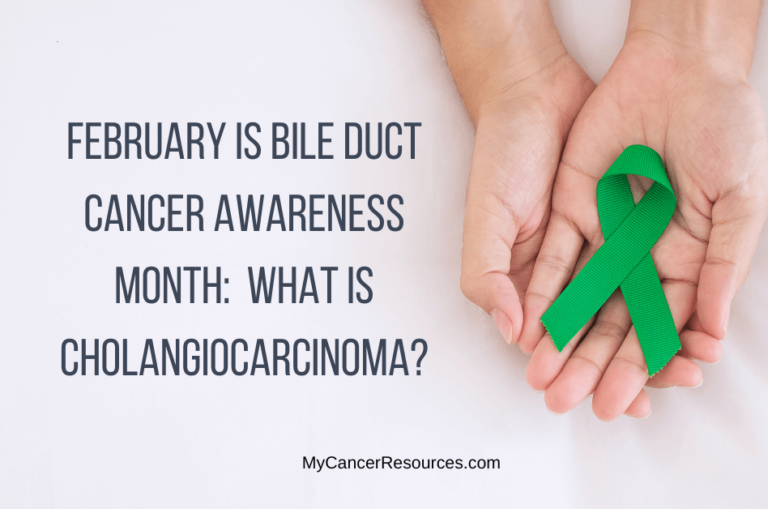
The month of February is bile duct cancer awareness month. Not many know about this rare cancer, which is also called cholangiocarcinoma.
This article will review what the bile ducts are and how they’re important to your body, signs and symptoms of bile duct cancer, and how it’s diagnosed and treated.
Understanding the Bile Ducts
Bile is a liquid made in the liver to help in the digestion of fats. Thin, tube-like vessels called bile ducts transport bile from the liver to the gallbladder, pancreas, and small intestine to help digest the food you eat.
Bile duct tumors develop when cancerous cells develop and multiply within different parts of the bile duct.
Types of Bile Duct Cancer
The National Cancer Institute identifies two types of cholangiocarcinoma. They’re named based on where the cancer is located.
Intrahepatic: intra = inside and hepatic = liver. This cancer is found in the bile ducts inside of the liver.
Extrahepatic: extra = outside. This cancer originates in the bile ducts outside of the liver. There are two subtypes of this kind of cancer:
- Perihilar bile duct cancers form just barely outside of the liver.
- Distal bile duct cancers form where the ducts from the liver and gallbladder join to form the common bile duct
The bile duct system is also called the biliary system. These cancers can also be referred to as biliary tract cancers.
All bile duct cancers are very rare. Bile duct cancers are difficult to diagnose because they develop in parts of the body that are hidden by other organs, and the symptoms are similar to other common diseases, so it can take a long time to be accurately diagnosed.
I write these types of articles to spread education and awareness. By educating ourselves and spreading information, we can advocate for more research into this type of cancer and find ways to detect it sooner so that bile duct cancer patients can have a better quality of life and improve their chances of survival.
Facts and Statistics about Bile Duct Cancer
Here are some statistics about bile duct cancer:
- According to the American Cancer Society, around 8,000 people in the United States are diagnosed with bile duct cancer each year.
- The average age at diagnosis when it’s found inside the liver is 70.
- The average age at diagnosis when it’s found outside the liver is 72.
- It affects men and women almost equally.
- In the U.S., bile duct cancer affects more Hispanic Americans that any other ethnic group.
- It is much more common in China and Southeast Asia due to high infection rates of liver flukes, which is a type of parasite.
- Bile duct cancers are often found in advanced stages, and because of that, are much harder to treat successfully
Risk Factors for Bile Duct Cancer
There are some common risk factors that increase the likelihood of developing this disease. These include:
- Infection with liver fluke parasites
- Chronic liver diseases
- Exposure to certain chemicals including asbestos and radon
- History of gallstones
- High alcohol consumption over a long time
- Long term Hepatitis B or C infections
- Obesity
- Smoking
- Genetic factors may play a role, though bile duct cancer is not considered to be a hereditary disease
Signs & Symptoms of Biliary Cancer
Early stages of bile duct cancer often shows no recognizable symptoms. It’s only when the cancer cells grow and spread that symptoms start to appear.
Common symptoms include:
- jaundice (yellowing of the skin or whites of the eyes)
- dark urine
- pale, clay colored stool
- abdominal pain, especially in the right upper corner of the abdomen
- fever
- itchy skin
- nausea and vomiting
- unexpected weight loss
Diagnosing Bile Duct Cancer
Since bile duct cancer is rare and symptoms don’t show up until the cancer is more advanced, diagnosing it in early stages can be very difficult. But early detection makes a world of difference in terms of having more treatment options and improving the patient’s quality of life.
A lot of tests and scans may need to be done to diagnose bile duct cancer because it can look like other diseases or other types of cancer. If you are experiencing symptoms, advocate for yourself and find a doctor who will continue running the necessary tests to hopefully catch this devastating cancer as early as possible.
The following procedures and tests might be used to diagnose bile duct cancer:
- Physical exam which includes evaluating your symptoms and health history
- Blood tests
- Liver function tests – blood samples are checked to review for abnormal liver enzymes and for high levels of bilirubin, both of which can indicate liver disease caused by bile duct cancer
- Tumor marker and CEA tests – tumor markers are released into the blood by tissues, organs, or tumor cells. Higher levels of CEA (carcinoembryonic antigen) and CA 19-9 tumor marker may be a sign of bile duct cancer
- Ultrasound
- CT scans or MRI scans
- MCRP – similar to an MRI, this procedure uses a magnet, radio waves and a computer to take detailed pictures of areas deep inside the body, including the liver, bile ducts, pancreas, and gallbladder
Treatment
Treatment options can vary greatly depending on the stage of the cancer when diagnosed and the patient’s overall health. Surgery is typically the preferred option for removing the tumor and affected portions of the bile duct.
When bile duct cancer is discovered in a late stage and even stage IV, meaning it has spread to more distant areas of the body, treatment plans may include a combination of surgery, chemotherapy, and/or radiation therapy to control the growth of cancer cells and relieve symptoms.
Immunotherapy is a type of treatment that uses the patient’s immune system to fight cancer. This is another type of treatment that can be used for bile duct cancer.
Clinical trials are when new drugs are tested to see how effective they are against a certain type of cancer. They may be brand new drugs, or those that have already been approved to treat other cancers or other diseases, but scientists believe they could also work on bile duct cancers.
Additional cancer research, including clinical trials are very important, especially for rare forms of cancer, so that new and more effective treatments can be discovered.
Conclusion
Bile duct cancer is rare, and that’s why cholangiocarcinoma awareness month is important. Because there’s an overall lack of knowledge and awareness of biliary cancer, it’s important to spread the word to know what to look for.
Treatment options and survival rates are so much better if the disease is caught early, so pay attention to symptoms and work with your healthcare team to conduct the necessary tests for an accurate diagnosis.
If you’ve been diagnosed with bile duct cancer or any other cancer and need extra support for your journey, reach out to me and let’s talk about how I can help.



